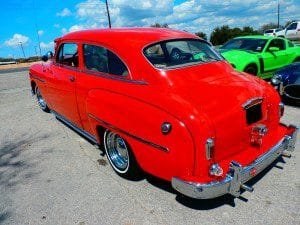The Wayfarer was the low-priced model in the all-new 1949 Dodge lineup, offering a minimum of chrome and other stylish trim and accessories. There were three body styles offered with the Dodge Wayfarer. These included a three-passenger business coupe, a fastback sedan, and a convertible roadster.

The car featured in this article is a 1949 Dodge Wayfarer Fastback Sedan.
When you look at Dodge during the late 1940’s and early 1950’s, the automobiles were noted for their excellent engineering. Styling wasn’t necessarily a strong suit. The Dodge Wayfarer offered a hybrid of standard and automatic transmissions. This transmission system combined a conventional manual clutch with a hydraulic coupling. The Wayfarer could accelerate from a stop without using the clutch In the years before fully automatic transmissions became widely available, the Dodge Fluid Drive was a popular feature.
In essence, the Fluid Drive, a trademark of the Chrysler Corporation, was an early attempt at a semi-automatic transmission. The mechanism had characteristics of both a manual and automatic transmission. Chrysler’s Fluid Drive first appeared in 1939 and continued to 1954. It was used on Chrysler, De Soto and Dodge models.
Dodge Wayfarer Styling
As mentioned above, the lower priced Dodge Wayfarer didn’t lead the pack in styling. After all, the car was advertised as a low priced Dodge model so styling wasn’t a huge selling point. The car was boxy and conservative for these model years. The model did however have a new grille with a chrome badge which added a nice touch. By the same token, the slab sides and tall roof line did allow a roomy cabin with excellent headroom. Men and women could step in and out of the Wayfarer comfortably with their hats on. It’s a car that loooked low on the outside but high on the inside.
The Wayfarer received styling facelifts in both 1950 and 1951 although the cars were still very conservative looking. In 1950 the roadster model became the “Sportabout”.
1949 Dodge Wayfarer Specifications
The Dodge Wayfarer was built with a 230 cubic inch in-line L-Head six cylinder engine with a rated 103 horsepower. Top speed was rated at 75 MPH and, surely not being a muscle car, the Wayfarer did the 0 to 60 in about 25 seconds. This same base engine contunued throughout the Wayfarer production run.
Transmission was a Chrysler Fluid-Drive hybrid automatic. It had two gear positions. These were low, governing first and second gears, and high for third and fourth. The transmission did have a clutch which was only used to switch between low and high.
Brakes were four wheel drum.
Dimensions for the 1949 Dodge Wayfarer included a 115.0 inch wheelbase.
The independent front suspension used coil springs and the rear used semi-elliptic leaf springs.
The Dodge Wayfarer Sedan shown here weighed 3,180 lbs. The model sold new for a bit over $1,700.
The 1949 model year still enjoyed the effects of pent up buyer demand due to the war years. Dodge, as a division, sold a bit over 250,000 vehicles for the 1949 model year. Total Dodge Wayfarer production for 1949 were 63,800 vehicles. The two door sedan was the biggest seller at 49,000 units. The next year, 1950, Wayfarer production increased by about 12,000 units and the Wayfarer Sedan increased by about 16,000 units.
See the additional Auto Museum Online articles on the links below…
A Finely Restored 1940 Dodge Convertible Coupe
Locating Serial Numbers on Classic and Vintage Automobiles
1955 Buick Special Two Door Sedan
Dodge Wayfarer Collector Cars
The Dodge Wayfarer was a lower priced Dodge offering with a somewhat boxy style and, while very functional, is not typically a hot collector car. By the same token many believe they represent the last of the true American roadster. All in all, restored Dodge Wayfarers can be good values.
Restored Dodge Wayfarers may be priced in the $15,000 to $29,000 range. Convertibles will generally be on the higher end. Non-restored models should be well under $10,000.
(Article and photos copyright 2015 Auto Museum Online)



